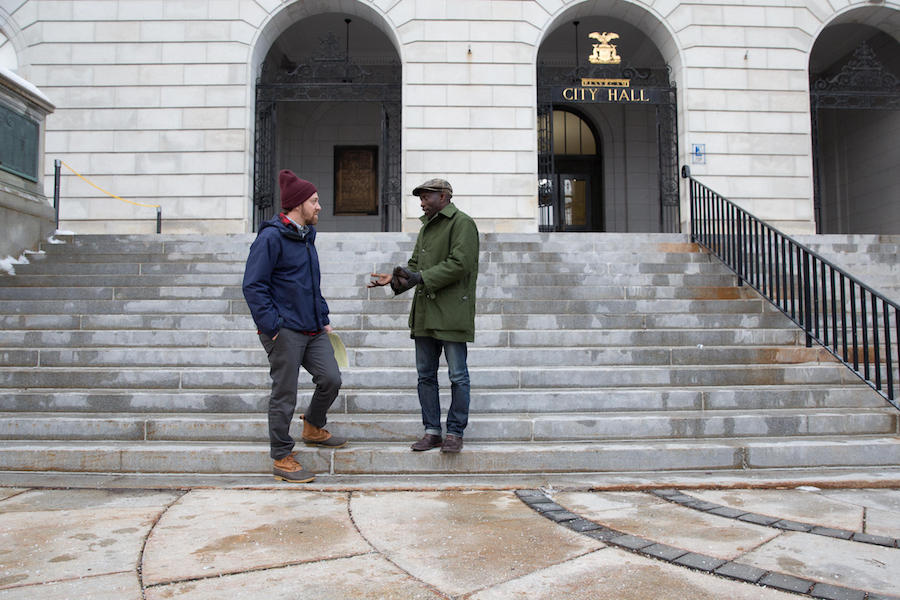
Greater New Haven | Hartford | Radio & Audio | Arts & Culture | NENC | NEXT
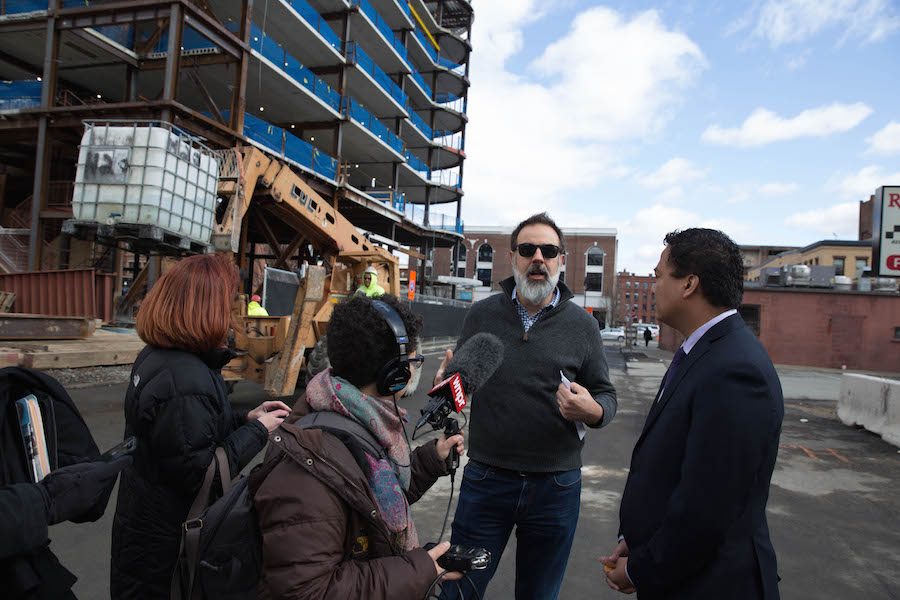 John Dankosky interviews Mike Mathis of MGM at the construction site of a resort casino in downtown Springfield, Mass. NEXT Producer Andrea Muraskin records the conversation. Photo by Ryan Caron King for NENC.
John Dankosky interviews Mike Mathis of MGM at the construction site of a resort casino in downtown Springfield, Mass. NEXT Producer Andrea Muraskin records the conversation. Photo by Ryan Caron King for NENC.
Producer Andrea Muraskin had referenda on the brain. It was a rainy November Monday in Hartford, and she had spent the weekend catching up on elections across New England.
She’d been scanning local news outlets and radio affiliates in Connecticut, Massachusetts, Maine, New Hampshire, Vermont and Rhode Island for news about ballot measures. Two stuck out: Maine’s voter approval on Medicaid expansion, and Massachusetts’ continued webbing around recreational marijuana, one year after voters voted to legalize and regulate.
Two years ago, the multi-state story might not have belonged in this dreary conference room in Hartford. Now, it’s one of the things propelling the future of public media in New England—if it can find the resources to sustain itself for the foreseeable future.
That’s the story behind the New England News Collaborative (NENC), a budding experiment in regional news and broadcast journalism. Currently funded by a $625,538 grant from the Corporation for Public Broadcasting (CPB) that came through in Feb. 2016, the collaborative comprises Connecticut Public Broadcasting Network, Boston's WBUR, Maine Public Broadcasting Network, New Hampshire Public Radio, Vermont Public Radio, New England Public Radio, Rhode Island Public Radio, and WSHU Public Radio. In April of 2016, WNPR’s John Dankosky was named its executive editor.
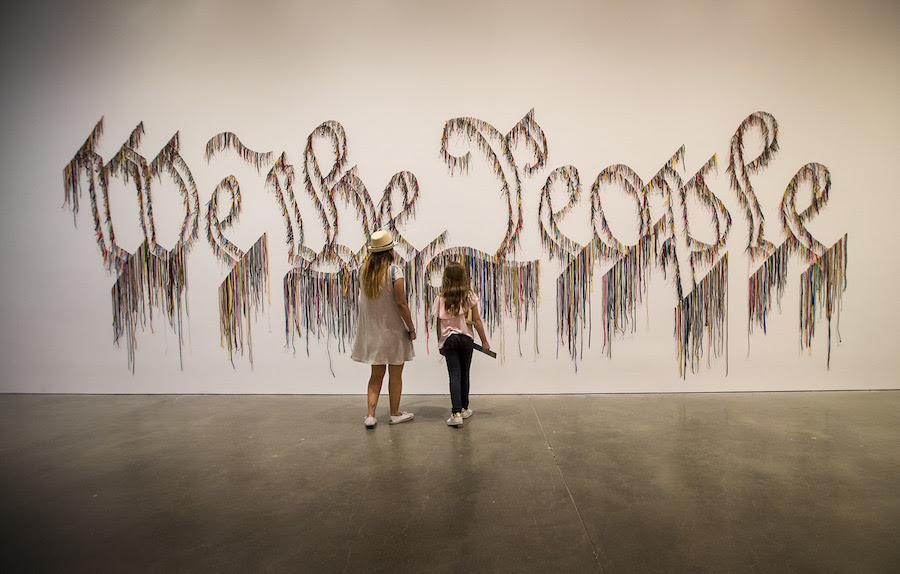 Visitors approach a work by Nari Ward, made from shoelaces, at an art show about the immigrant experience at Boston’s Institute of Contemporary Art. Photo by Jesse Costa for WBUR.
Visitors approach a work by Nari Ward, made from shoelaces, at an art show about the immigrant experience at Boston’s Institute of Contemporary Art. Photo by Jesse Costa for WBUR.
There are two parts to the collaboration. The first, and largest, is a near-daily content share between the eight NENC stations and NPR flagship programs like “Morning Edition,” whereby a piece from one station might get exposure on several, to tell the greater story of a region. That’s part of what the grant pays for—a reporter at each station who is specifically part of the collaborative, and dedicated to local perspectives on regional issues.
The second is NEXT, a weekly, hour-long broadcast that brings together stories from across the region. In reporting out stories from six states (and eight affiliates), it’s meant to get at regional trends and outliers alike—like a recent episode that took listeners through referenda in Maine and Massachusetts, a Puerto Rican family reunited in Massachusetts, a veteran using farming to cope with PTSD, and a soothing visit to a tucked-away pond in Sandwich, New Hampshire.
A central thesis holds the moving parts together: The region is changing more rapidly than other parts of the country. This is the way to keep up with it.
“Here’s my sales pitch for that,” Dankosky said in a recent interview. “We’re the oldest part of the country. Meaning not just that our physical infrastructure is old—which it is—but our people are aging. Aside from the greater Boston market, you basically see out migration as opposed to in migration. But where you see immigration into our region, it’s seen as … the savior of New England. At least from a demographic standpoint. You have younger people coming in, who are having kids here, who are raising families here, who are changing the makeup of a region. Which if you look, has been overwhelmingly white, overwhelmingly older. That causes tensions, but hopefully it causes a lot of opportunities.”
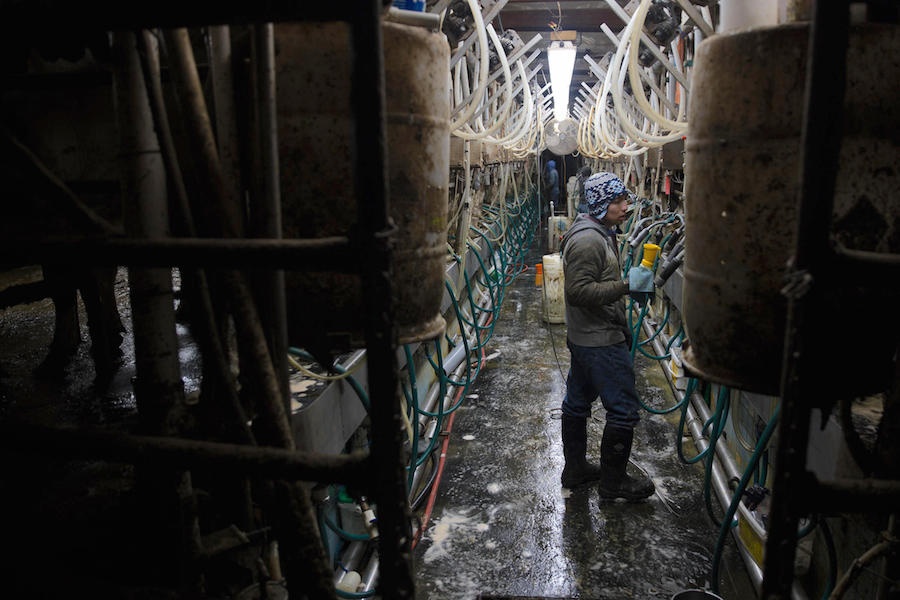 Miguel Alcudia, a Mexican national, milks cows in a Vermont dairy. He was arrested by ICE last year on the grounds that he’s living in the country on an expired visa. Photo by Ryan Caron King for NENC.
Miguel Alcudia, a Mexican national, milks cows in a Vermont dairy. He was arrested by ICE last year on the grounds that he’s living in the country on an expired visa. Photo by Ryan Caron King for NENC.
That’s been particularly true of some of the stories in NENC’s “Facing Change” series, reported out over 2016 and 2017. In late 2016, Vermont Public Radio Reporter Kathleen Masterson (she has since left VPR) brought listeners and readers the story of Miguel Alcudia, who was detained in Immigrations and Customs Enforcement (ICE) despite Obama-era guidelines that put an end to random detainments, arrests and deportations. As a rash of similar cases rose across New England, Masterson’s piece became a sort of case study on how and where those laws are broken, and how they’re changing with a new administration in the White House.
Or its environmental reporting, which has tracked over six states how climate change and the Northeast’s precipitous warming is affecting the region—and the country—in real time. In one episode, Dankosky and Muraskin travel the Long Island Sound with author Patrick Lynch, exploring its biodiversity and how sea level rise will affect it. In several others, reporters explore how their states, towns and neighborhoods are preparing for rising temperatures, increased rainfall, and more frequent storms.
Not all of the reporting is so news-driven, Muraskin noted. Typically the last segment of NEXT is dedicated to a short regional story that might leave listeners scratching their heads and thinking about how things are different just a state or two away. She recalled a personal favorite, from New Hampshire Public Radio’s Sean Hurley just before the 2016 presidential election. Hurley had met a farmer named Chris Owens, who’d made his outhouse into an “Official NH Voting Booth.” It was quirky, and utterly unexpected, and wonderful. Who would have known about it otherwise, she asked?
 Pious Ali chats with a constituent on the steps of city hall in Portland, Maine. Elected in 2016, Ali is the first African-born Muslim to serve on Portland’s city council. Photo by Ryan Caron King for NENC.
Pious Ali chats with a constituent on the steps of city hall in Portland, Maine. Elected in 2016, Ali is the first African-born Muslim to serve on Portland’s city council. Photo by Ryan Caron King for NENC.
“We’re getting stories from all over the place, so sometimes it’s not entirely clear,” said Catie Talarski, who serves as the show’s executive producer (she also produces WNPR’s Where We Live and The Wheelhouse each week). “But if you think of an old New England quilt, it’s kind of like we’re just piecing together bits of the region.”
But the NENC is also a salve in a changing media landscape. It comes out of a supply and demand problem that public media affiliates, and newsrooms more broadly, are experiencing as resources shrink. By Dankosky’s estimation, WNPR and similar stations do “a pretty great job of training reporters.” But there’s no pipeline up and not enough money for new editors, leaving close to 300 public radio stations without the oversight they need. With the collaborative model, stations are able to both hone in and step back, getting viewpoints that tell a larger story.
“Our listeners don’t just want local news,” he said. “And they don’t just want regional news. And they don’t just want national or international news. They want something that spans everything. And so the idea of regional hubs helps us build that bridge.”
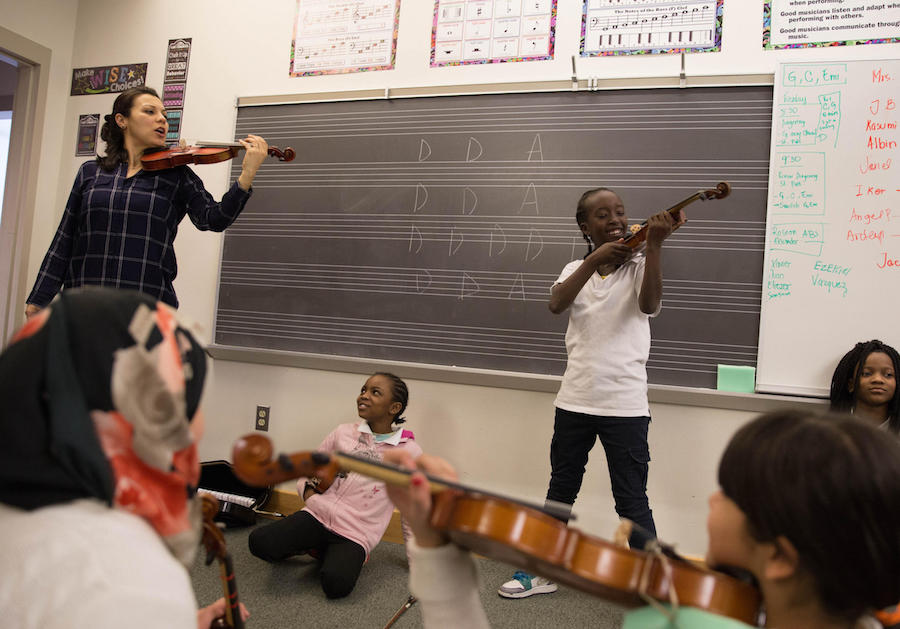 Yaira Matyakubova teaches a violin class for refugee children at Music Haven in New Haven, Conn. Photo by Ryan Caron King for WNPR.
Yaira Matyakubova teaches a violin class for refugee children at Music Haven in New Haven, Conn. Photo by Ryan Caron King for WNPR.
The collaboration is reflective of a greater regional trend that’s taking over the National Public Radio landscape. In June 2017, NPR’s then-Senior Vice President of News and Editorial Director Michael Oreskes (he has since been placed on leave following allegations of sexual harassment in the workplace) announced a shift to NPR-Member Station Collaborative Journalism Network, with regional hubs across the country. In that new model, journalists dig deep on both hyper-local, state and regional trends with a regional editor—and would-be competitors become collaborators instead.
Now, the NENC’s biggest hurdle is funding to make the project sustainable. Distributed across the eight NENC stations in 2016, the CPB grant is only intended to cover the first two years of NENC’s existence. That second year will end in 2018—and Dankosky is thinking about what a working model will looks like going forward.
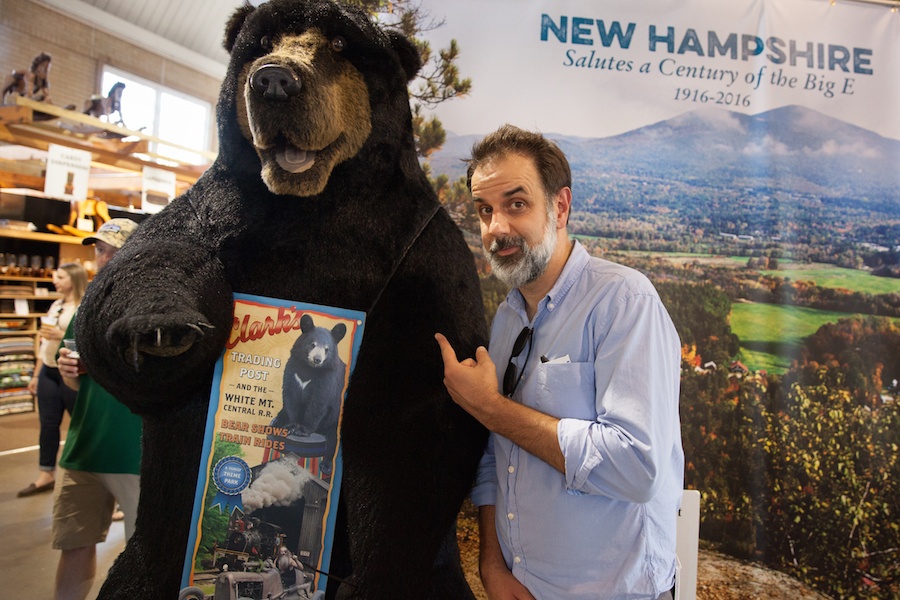 John Dankosky poses with a new friend in the New Hampshire Building at the Big E. Photo by Ryan Caron King for NENC
John Dankosky poses with a new friend in the New Hampshire Building at the Big E. Photo by Ryan Caron King for NENC
Dankosky said that he has a long-term vision of a huge network newsroom “in which we know what everyone else is doing and we’re very very functional and we’re only assigning one reporter to a story as opposed to three different reporters at three different stations. But that’s a long way off. “
“I’ve been on this two year plan where it’s like: Okay. For two years, it’s gonna be a big experiment,” Dankosky said. “We’re gonna try a lot of things, we’re gonna work really hard, we’re gonna fail a lot, probably, and we’re gonna push people into some uncomfortable territory as far as sharing content and working regionally. And then at the end of two years, we’re going to figure out which of these things are sustainable and worth investment of time and money.”
But Muraskin said she sees a robust future for it, because it is telling a story in a different and compelling way. Listeners are taking note: NPR reported that it experienced historic highs in 2016 and 2017 listenership. Some of those are the hundreds of thousands of people who hear NENC coverage and NEXT across partner stations, she said.
“There’s not a lot of places that cover New England,” she said. “It’s basically The Boston Globe, us, and Yankee Magazine. I think sound is powerful, and then within that we’re providing a way for people to get this sense of where they live. There’s something about driving in your car and thinking ‘Oh! This is a show about New England! This is for me. It helps me understand where I live.’ And that’s pretty cool.”
NEXT is hosted by John Dankosky. Andrea Muraskin is the producer and Catie Talarski is the executive producer. To find out more about the New England News Collaborative, check out its website. NEXT plays on WNPR each Thursday at 2 p.m. and WNHH Community Radio on Saturdays at 8 a.m. More information about the podcast is available here.

